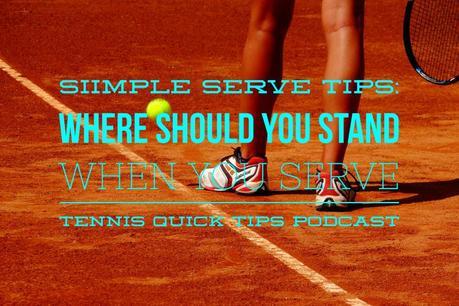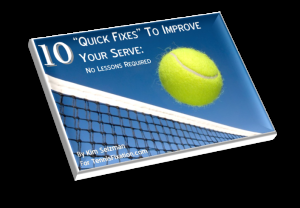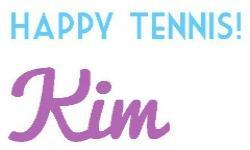Podcast: Play in new window | Download
Welcome to my Simple Serve Tips series! This is the first episode in my brand new series, Simple Serve Tips. You and I both know that there are so many moving parts to the serve and it can be hard to get a handle on all of them. So, in this series, we're going to look at the entire serve picture - every little bit of it and how each piece can be improved upon to make your serve a better, more reliable tool in your game. Maybe you're happy with your serve. You can listen to this episode by clicking on the media player above or by listening in with your favorite podcast app. You can also subscribe in iTunes by clicking on this link: tennisfixation.com/itunes.

SHOW NOTES:
The Simple Serve Tips Series
Maybe you think your serve is perfect and needs no adjusting or tweaking. But even at the pro level, we see players constantly working to improve their serve. So the Simple Serve Tips series is here to talk about the various parts to the serve and to help you discover what kind of tweaks you might make to improve your own serve. I encourage you to listen in no matter what the quality of your serve because sometimes just re-thinking what you're doing when you're serving can have a huge impact on the quality of your serve.
Where Should You Stand When You Hit Your Serve?
In this first episode in the Simple Serve Tips Series, I talk about where you should stand when you hit your serve and how you can take best advantage of your serving position on the baseline.
In last week's episode, I told you that I had just started teaching adult beginner tennis. I am teaching a four week long clinic and I have some ladies in this very first session who have never played tennis before and I promised them that in four weeks I would teach them enough that by the end of it they would be able to go out and play a game of tennis. Maybe they won't play a game well, maybe they won't win a game of tennis, but they would know enough to get out on the court with their friends and make it through a game of tennis without embarrassing themselves. Which is actually a big stumbling block for a lot of people getting started. They don't want to go out and play because they are afraid they will go out and embarrass themselves in front of their friends.
Because it is only four weeks and because I made this big promise, we are basically blowing through the tennis information. In the first week we learned the forehand, the backhand and the volley, and in the second week I worked on them being able to move from the baseline up to the net to hit a volley. In other words, they had to hit an approach shot and then hit a volley.
I also started out teaching them the serve. And one of the very first questions I got as I was starting to teach them this serve was, "Well, where do I stand?" I thought this was a good question because, on the one hand, there was a simple answer. You stand back on the baseline behind that center hash mark and either the singles side line or the far doubles line, basically the edge of the court depending on if you are playing singles or doubles. This is what the rules tell us and I actually did an entire podcast episode on this, what the rules say about where you are permitted to stand. You can find that if you want to know exactly what the rule say by going to tennisfixation.com/quicktips60. That gives a good long discussion of what the rules tell you.
As you can imagine, especially since I know you who are listening to this are not beginner players who have never gotten on the court to play the game before, there are actually a lot of places you can stand between that center half way mark, that little hash mark at the back of the baseline, and either going towards your right if you are serving from the deuce side or towards your left if you are serving from the ad court. There are a lot of positions you could take on that baseline that would be within the rules.
So how do you know exactly where to stand when you are serving? What is the ideal position to take back on the baseline? Well, I think they are three things that you need to think about when deciding where you want to serve from, what position you want to take on the baseline. I am going to tell you what those three things are and they are the things that I think you should be thinking about every time you get up to take a serve and I am going to tell you what you need to take into consideration when you are thinking about these three things.
1. Where Do You Need To Position Yourself To Get To The Return?
Number one, the first thing you need to think about when you are deciding where to stand when you are hitting your serve is where do you need to be when to get the return back. You hit your serve, your opponent returns, what is the best place for you to be standing so that you are ready for that return?
Now, you know if you are playing singles and you are the server, you are out there covering the entire court from single side-line to single side-line. You are out there covering it all by yourself. You don't have any one to help you out and so you have got to be ready for anything. You've got to be ready for the cross court return and you've got to be ready for the down the line return. So when you are deciding where to serve from in singles you probably want to stand a little bit closer to that center mark. Either on the deuce side of it if you are serving from the deuce court or the ad side of it if you are serving from the ad court. You need to be a little bit closer to that half way mark because you've got to be ready to either break towards your right or your left depending on where the return comes.
In fact, if you watch the pros play you will see they stand really close to that center line. Sometimes they almost look like they are standing on it. You cannot stand on it, that is against the rules, but you can stand very close to it. Myself, when I serve, I stand a little bit to one side or the other of it, maybe like a foot off it. I just don't feel like I can really hit the kind of serve I want if I am standing right there in the middle but I certainly do stand much closer to it when I am playing singles than when I am playing doubles.
That's because when you are playing doubles you don't need to be quite as close to that center mark because you have a partner out there. You've got your partner to help cover that down the line return and you have your partner to even help you with those returns that come up the middle that hopefully your partner will be able to poach. That allows you to shift over a little bit, either to your right or your left depending on which side of the court you are serving from, you can move away from that center mark and be able to cover the outside of the court more since now the whole doubles alley has come in to play and the returner might be going out wide like that. You're able to cover that because you don't have to be quite as close to the middle of the court because you have a partner. So, the number one thing you are thinking about when deciding where to stand when you are serving is what kind of return do you need to be prepared for.
2. What Is The Target Of Your Serve?
Number two, the next thing to think about when choosing a spot to stand at to serve is what's your target? Where do you want to send your serve? It is a lot easier to serve up the middle if you are standing closer to the middle and when I say to serve up the middle you certainly can hit that middle area no matter where you are standing, no matter how wide you are but you can imagine you are going to have less of an angle. Your serve is going to travel more and stay more up towards the middle of your opponent's court if you are at the middle. It is going to be more of a straight line. If I am hitting that middle spot from further out, I am going to be hitting more of an angle even when I hit that middle position and that is a much easier serve for my opponent to return if the serve is not causing them to have to lunge out towards the middle. If I want to hit the middle I want to draw my opponent over to the middle when they hit their return and hopefully they are going to do that and leave some area open that I can hit into on the next shot.
So my target will help me determine where I want to stand on the baseline when I am serving. As I said if my target is up the middle I can place myself closer to the middle and more easily hit a serve that is going to go up the middle. If I want to hit a wide serve, especially if I want to hit a short wide serve, then the further I move out, the wider I get, the easier it is for me to hit that wide serve especially the short wide serve.
What's the drawback to all of this? The drawback is I have to be careful about just how much I exaggerate this position because my opponent at this point is probably smart enough to figure out the closer I stand to the middle the more likely it is that I am trying to get this serve up the middle. The more wide I stand, the more likely it is I am trying to hit my serve out wide. I've got to be able to not tip off my opponent to what's coming by my position and that brings up point three.
3. How Can I Use My Position To Confuse My Opponent?
The third thing that you need to think about when choosing your baseline position for serving is where you can stand that will hopefully confuse your opponent or at least throw them off balance. Your ultimate goal is to be able to hit a number of serves from whatever position you take on the baseline. I am going to use myself as an example right here. Right now, I am very confident in my ability to take a position that is, maybe when I am playing doubles about two feet, maybe a little less off the center mark. I know I can take that position to hit my serve and I will be able to get to almost any return that comes back over and I can also hit a number of targets from that position. I know I can take that position and serve it up the middle, serve it into the body and serve it out wide. I feel pretty good about that. So I know that when I am standing there, my opponent cannot look at me and make a guess about what's about to happen as far as where my serve is going to come.
Ultimately, what I would like to be able to do is to do that very thing, hit a number of targets but from a number of different positions. If I could do that then I wouldn't just throw my opponent a little off balance. I would probably totally confuse them. If I could hit from three different positions on the base line, if I could hit three or four types of serves, an up the middle serve, a body serve, a wide serve and a short wide serve, and also throwing in different types of spin, I would be ecstatic about the quality of my serve. No matter how hard it was, just the ability for me to move around and move my serve around would be really good.
I am not there yet but that's my ultimate goal, to be able to hit a number of targets from a number of different spots on the baseline. So that is the third thing you want to be able to do. You want to be able to choose a place to stand that will hopefully throw your returning opponent off balance or at least make them wonder what is going to come over, I don't know where this person is going to serve, what their serve target is, I can't tell just from where they're standing on the baseline.
So Here's What To Think About . . .
So those are the three things I think you need to be thinking about when you are taking your position on the baseline to hit your serve and those three things again were (1) where you need to be standing so that you are in position when the return comes back over, (2) where you need to be standing so that you can hit your target and (3) where you need to be standing to throw your opponent off balance enough so that they don't know what is coming at that.
Get Out There And Practice Your Serve!
The best way to do all of these things is to get out there and practice your serve and, for me, that's the only way I am going to achieve that third thing where I can stand in a number of positions and hit a number of different serves. I am just going to have to get out on the court and practice doing that. I do not feel confident about pulling that kind of behavior out during a match because I just have a lot of other things I am thinking about and I want to know that my serve is going to be the reliable tool that it is right now. If I could make the time to get out there and practice I am sure it wouldn't take me long to get to that position where I can hit a number of different serves from a number of different positions. So don't be like me, don't be the person that wishes they could do that. Be the person that gets out there, practices and achieves that.
That's it for this week's Tennis Quick Tip. I hope you got something out of that and I hope it makes you think a little bit, even if you are going to go right back to the same spot you always go to. At least it gives you a little bit of something to think about next time you take up that position on court.
Let me know what you think and let me know what you think about the whole Simple Serve Tips series, if you think that is a good idea and if it's something you are looking forward to. You can do that by leaving a comment below. I would love to hear from you. I hope you are getting outside and playing a lot of tennis. Right now, the weather is still beautiful here in Houston and so I feel like I am getting out and playing a lot and I am loving it.
RESOURCES AND LINKS FROM THIS EPISODE:
SHARE, SUBSCRIBE AND REVIEW:
Thanks so much for being a listener and friend of the Tennis Quick Tips podcast. And I hope you'll consider sharing this podcast with your friends and leaving a review of the show as it really helps it to be found by other like-minded tennis players. You can listen in, subscribe or leave a review by going to:
GET A BETTER SERVE FAST!
And if you're interested in getting a better serve - fast! - get my free ebook, 10 Quick Fixes to Improve Your Serve: No Lessons Required.

By applying the 10 simple tips to your serve that I give in this ebook, your serve can become a tool that you can use to gain control of points. It can become more powerful, more accurate, and something you're actually proud of. Just enter your email below and you'll get instant access to this free ebook as well as weekly updates with all of my best tennis tips!

© Kim Selzman 2015 All Rights Reserved

